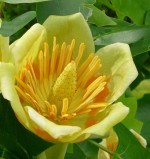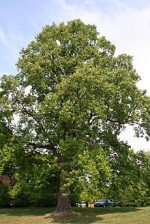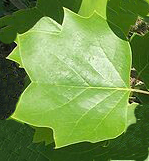 Our farm in New Jersey includes a small mountain with a seven or eight acre grove of tulip trees growing on top. The trees large size, tall straight trunks, and high foliage provide a cathedral-like environment that is similar to a redwood forest. For years we thought someday we would move to the farm and build a house in this grove. The site had originally been home to chestnut trees but when chestnut blight infected them they were cut for timber and the hauled away. The lumbering activity opened the land to the sun and disturbed the soil which allowed the seeds of tulip trees to germinate and grow into this lovely grove. There are only a few other tulip trees anywhere else on the farm and so this one place where they do grow is very special. When the time came to build we could not bear to disturb this “sacred grove” of beautiful trees and we built elsewhere.
Our farm in New Jersey includes a small mountain with a seven or eight acre grove of tulip trees growing on top. The trees large size, tall straight trunks, and high foliage provide a cathedral-like environment that is similar to a redwood forest. For years we thought someday we would move to the farm and build a house in this grove. The site had originally been home to chestnut trees but when chestnut blight infected them they were cut for timber and the hauled away. The lumbering activity opened the land to the sun and disturbed the soil which allowed the seeds of tulip trees to germinate and grow into this lovely grove. There are only a few other tulip trees anywhere else on the farm and so this one place where they do grow is very special. When the time came to build we could not bear to disturb this “sacred grove” of beautiful trees and we built elsewhere.
 Tulip trees have several features that make them a desirable tree. Their lyre shaped leaves are bright green in spring turning golden yellow in autumn and provide a pleasing shade in summer. The green and orange tulip-like flowers have abundant nectar and are very attractive but are produced after the leaves so their not showy. Since the tree must be at least 10 years old to bear blossoms, the flowers are high from the ground and not readily available for use in arrangements. Too bad! The straight trunk can grow up to 90’ high bears a pyramidal canopy. Roots are fleshy, wide spreading, shallow, and easily damaged by digging and compaction.
Tulip trees have several features that make them a desirable tree. Their lyre shaped leaves are bright green in spring turning golden yellow in autumn and provide a pleasing shade in summer. The green and orange tulip-like flowers have abundant nectar and are very attractive but are produced after the leaves so their not showy. Since the tree must be at least 10 years old to bear blossoms, the flowers are high from the ground and not readily available for use in arrangements. Too bad! The straight trunk can grow up to 90’ high bears a pyramidal canopy. Roots are fleshy, wide spreading, shallow, and easily damaged by digging and compaction.
Type: Deciduous tree.
Outstanding Features: Unique flowers and leaves; good shade tree.
Form: Pyramidal.
Growth Rate: Moderate to rapid (cultivars available with slower growth)
Bloom: Green and orange, 2” wide flowers in late spring.
 Foliage: Bright yellow-green, lyre-shaped, 6-8’ long leaves are simple, alternate, and turn yellow in fall.
Foliage: Bright yellow-green, lyre-shaped, 6-8’ long leaves are simple, alternate, and turn yellow in fall.
Size: 60-100’ H x 20-40’ W.
Light: Full sun.
Soil: Deep, rich, moist soils; slightly acid to neutral; needs water during dry spells.
Hardiness: Zones 5-9.
Pests and Diseases: Susceptible to aphids, sooty mold, leaf spot, and tulip leaf scale.
Propagation: Seed; cuttings.
Outstanding Selections:

 ‘Arnold’ (‘Fastigata’, 60‘ H, columnar, magnolia like flowers)
‘Arnold’ (‘Fastigata’, 60‘ H, columnar, magnolia like flowers)

 ‘Majestic Beauty’ (‘Aureo-marginatum’; yellow-edged leaves, 80’ H)
‘Majestic Beauty’ (‘Aureo-marginatum’; yellow-edged leaves, 80’ H)
